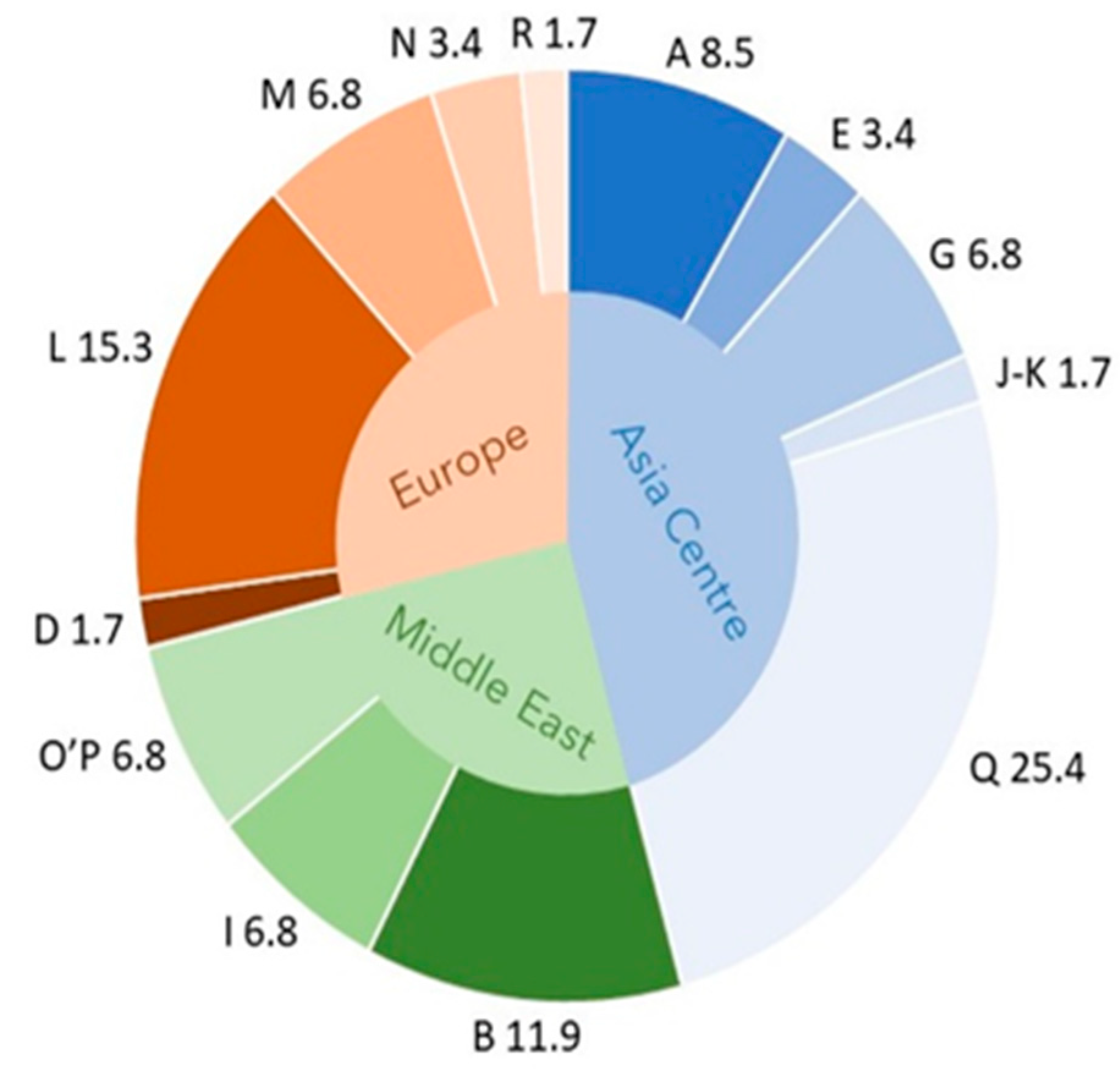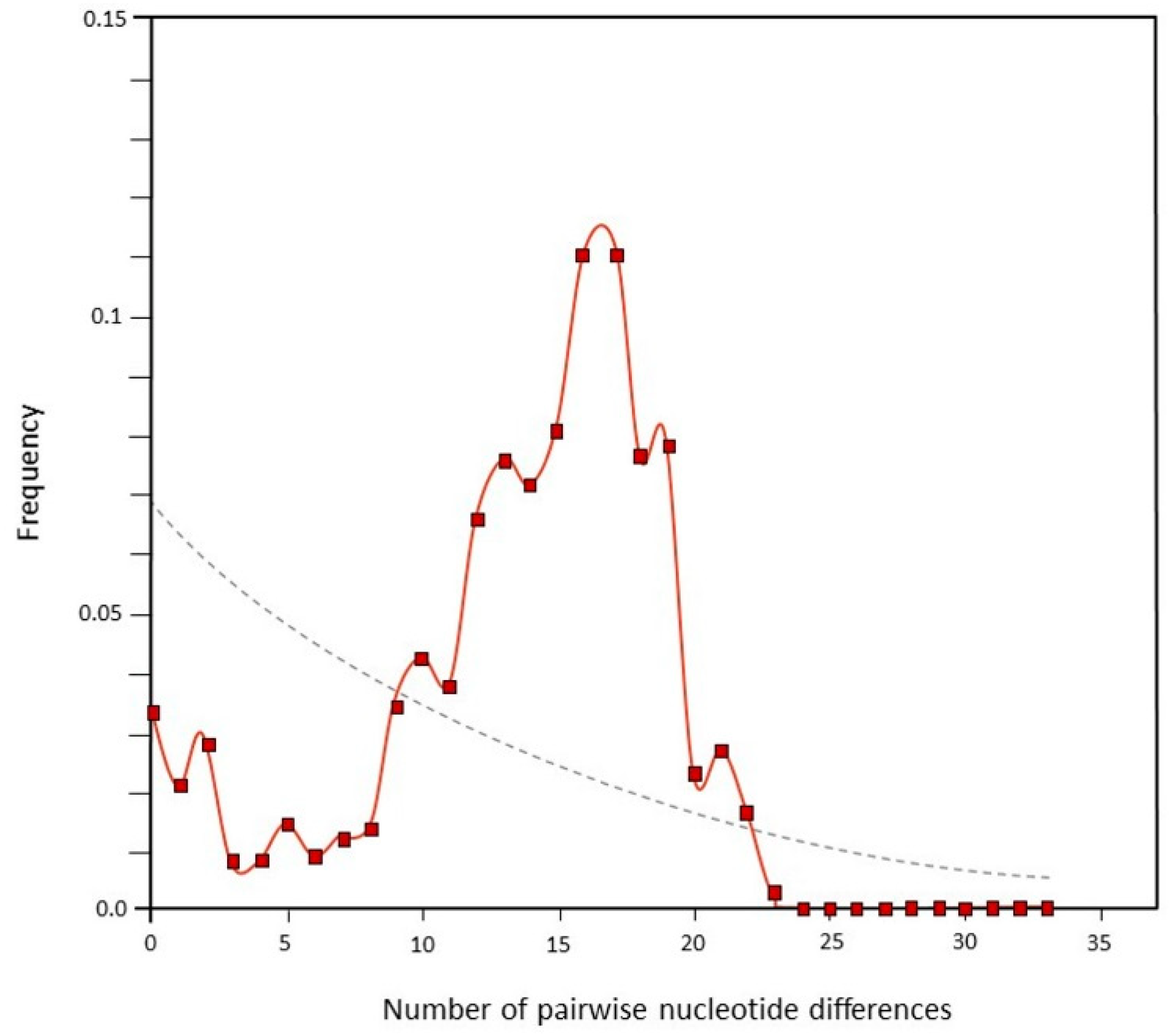Matrilineal Composition of the Reconstructed Stock of the Szekler Horse Breed
Abstract
1. Introduction
2. Materials and Methods
3. Results
3.1. D-loop Sequence Diversity
3.2. Prevalence of Haplogroups
4. Discussion
5. Conclusions
Supplementary Materials
Author Contributions
Funding
Institutional Review Board Statement
Informed Consent Statement
Data Availability Statement
Acknowledgments
Conflicts of Interest
References
- Wrangel, C.G. Siebenbürgen. In Ungarns Pferdezucht in Wort und Bild; Die Ungarische Landespferdezucht. Die Privatgestüte,Vierter Band; Verlag von Schickhardt & Ebner: Stuttgart, Germany, 1895; pp. 242–313. (In German) [Google Scholar]
- Hankó, B. Székely Lovak; Nagy Jenő és Fia Könyvnyomdája: Kolozsvár, Hungary, 1943; p. 26. (In Hungarian) [Google Scholar]
- Bodó, I.; Hecker, W. Lótenyésztők Kézikönyve; Mezőgazda Kiadó: Budapest, Hungary, 1992; p. 158. (In Hungarian) [Google Scholar]
- Hankó, B. Magyar Háziállataink; Ángyán Pál Tipográfiai Műintézet: Budapest, Hungary, 1943; p. 40. (In Hungarian) [Google Scholar]
- Bodó, I.; Hecker, W.; Surján, G.Y. A Székely Ló; Pharma Press Nyomdaipari Kft.: Budapest, Hungary, 2021; pp. 50–53. (In Hungarian) [Google Scholar]
- Ficsor, C.S. A Székely ló Fajta-Regenerálását Támogató Küllemtani Összehasonlító Vizsgálat. Master’s Thesis, Faculty of Agricultural- and Environmental Sciences, Szent István University, Gödöllő, Magyarország, 2016. (In Hungarian). [Google Scholar]
- Gáspárdy, A.; Ficsor, C.S.; Simon, L.; Bodó, I. A Possible Rescue of Székely Horse. The Breed “Székely ló” is Extinct, but the Type “Székely ló” Lives on (in Remote Areas of the Carpathian Mountains). Paper on “Unrecognised and Isolated Populations of rare Breeds and Varieties” 9th European Seminar on Agrobiodiversity and Annual Meeting of the SAVE Network, Lake Kerkini National Park, Greece, 11–13 September 2015. Available online: https://www.save-foundation.net/images/konferenzen/2015/Andras_Gaspardy_Szekely_Horse_2015.pdf (accessed on 5 January 2017).
- Achilli, A.; Olivieri, A.; Soares, P.; Lancioni, H.; Hooshiar Kashani, B.; Perego, U.A.; Nergadze, S.G.; Carossa, V.; Santagostino, M.; Capomaccio, S.; et al. Mitochondrial genomes from modern horses reveal the major haplogroups that underwent domestication. Proc. Natl. Acad. Sci. USA 2012, 109, 2449–2454. [Google Scholar] [CrossRef] [PubMed]
- Cardinali, I.; Giontella, A.; Tommasi, A.; Silvestrelli, M.; Lancioni, H. Unlocking Horse Y Chromosome Diversity. Genes 2022, 13, 2272. [Google Scholar] [CrossRef] [PubMed]
- Directive 2010/63/EU of the European Parliament and of the Council of 22 September 2010 on the Protection of Animals Used for Scientific Purposes. Available online: http://data.europa.eu/eli/dir/2010/63/oj (accessed on 8 July 2022).
- Giontella, A.; Sarti, F.M.; Cardinali, I.; Giovannini, S.; Cherchi, R.; Lancioni, H.; Silvestrelli, M.; Pieramati, C. Genetic Variability and Population Structure in the Sardinian Anglo-Arab Horse. Animals 2020, 10, 1018. [Google Scholar] [CrossRef] [PubMed]
- Tamura, K.; Stecher, G.; Kumar, S. MEGA11: Molecular Evolutionary Genetics Analysis version 11. Mol. Biol. Evol. 2021, 38, 3022–3027. [Google Scholar] [CrossRef]
- Rozas, J.; Ferrer-Mata, A.; Sánchez-Delbarrio, J.C.; Guirao-Rico, S.; Librado, P.; Ramos-Onsins, S.E.; Sánchez-Gracia, A. DnaSP 6: DNA sequence polymorphism analysis of large datasets. Mol. Biol. Evol. 2017, 34, 3299–3302. [Google Scholar] [CrossRef]
- Tajima, F. Statistical method for testing the neutral mutation hypothesis by DNA polymorphism. Genetics 1989, 123, 585–595. [Google Scholar] [CrossRef]
- Fu, Y.X. Statistical tests of neutrality of mutations against population growth, hitchhiking and background selection. Genetics 1997, 147, 915–925. [Google Scholar] [CrossRef]
- TIBCO Software Inc. Data Science Workbench, Version 14. 2020. Available online: http://tibco.com (accessed on 1 September 2021).
- Xu, X.; Arnason, U. The complete mitochondrial DNA sequence of the horse, Equus caballus: Extensive heteroplasmy of the control region. Gene 1994, 148, 357–362. [Google Scholar]
- Hristov, P.; Yordanov, G.; Vladov, V.; Neov, B.; Palova, N.; Radoslavov, G. Mitochondrial Profiles of the East Bulgarian and the Pleven Horse Breeds. J. Equine Vet. Sci. 2020, 88, 102933. [Google Scholar] [CrossRef]
- Moridi, M.; Masoudi, A.A.; Vaez Torshizi, R.; Hill, E.W. Mitochondrial DNA D-loop sequence variation in maternal lineages of Iranian native horses. Anim. Genet. 2013, 44, 209–213. [Google Scholar] [CrossRef]
- Cieslak, M.; Pruvost, M.; Benecke, N.; Hofreiter, M.; Morales, A.; Reissmann, M.; Ludwig, A. Origin and History of Mitochondrial DNA Lineages in Domestic Horses. PLoS ONE 2010, 12, e15311. [Google Scholar] [CrossRef]
- Elsner, J.; Deschler-Erb, S.; Stopp, B.; Hofreiter, M.; Schibler, J.; Schlumbaum, A. Mitochondrial d-loop variation, coat colour and sex identification of Late Iron Age horses in Switzerland. J. Archaeol. Sci. Rep. 2016, 6, 386–396. [Google Scholar] [CrossRef]
- Priskin, K.; Szabó, K.; Tömöry, G.; Bogácsi-Szabó, E.; Csányi, B.; Eördögh, R.; Downes, C.S.; Raskó, I. Mitochondrial sequence variation in ancient horses from the Carpathian Basin and possible modern relatives. Genetica 2010, 138, 211–218. [Google Scholar] [CrossRef]
- Jansen, T.; Forster, P.; Levine, M.A.; Oelke, H.; Hurles, M.; Renfrew, C.; Weber, J.; Olek, K. Mitochondrial DNA and the origins of the domestic horse. Proc. Natl. Acad. Sci. USA 2002, 99, 10905–10910. [Google Scholar] [CrossRef]
- Kusza, S.; Priskin, K.; Ivanković, A.; Jedrzejewska, B.; Podgorski, T.; Jávor, A.; Mihók, S. Genetic characterization and population bottleneck in the Hucul horse based on microsatellite and mitochondrial data. Biol. J. Linn. Soc. 2013, 109, 54–65. [Google Scholar] [CrossRef]
- Dell, A.C.; Curry, M.C.; Yarnell, K.M.; Starbuck, G.R.; Wilson, P.B. Mitochondrial D-loop sequence variation and maternal lineage in the endangered Cleveland Bay horse. PLoS ONE 2020, 15, e0243247. [Google Scholar] [CrossRef]
- Myćka, G.; Klecel, W.; Stefaniuk-Szmukier, M.; Jaworska, J.; Musiał, A.D.; Ropka-Molik, K. Mitochondrial Whole D-Loop Variability in Polish Draft Horses of Sztumski Subtype. Animals 2022, 12, 1870. [Google Scholar] [CrossRef]
- Ivanković, A.; Ramljak, J.; Konjačić, M.; Kelava, N.; Dovč, P.; Mijić, P. Mitochondrial D-loop sequence variation among autochthonous horse breeds in Croatia. Czech J. Anim. Sci. 2009, 54, 101–111. [Google Scholar] [CrossRef]
- Hristov, P.; Yordanov, G.; Ivanova, A.; Mitkov, I.; Sirakova, D.; Mehandzyiski, I.; Radoslavov, G. Mitochondrial diversity in mountain horse population from the South-Eastern Europe. Mitochondrial. DNA Part A 2016, 28, 787–792. [Google Scholar] [CrossRef]
- Khrabrova, L.A.; Blohina, N.V.; Bazaron, B.Z.; Khamiruev, T.N. Variability of mitochondrial DNA D-loop sequences in Zabaikalskaya horse breed. Vavilov J. Genet. Breed. 2021, 25, 486–491. [Google Scholar] [CrossRef]
- Rusu, T.; Moraru, P.; Coste, C.; Cacovean, H.; Chetan, F.; Chetan, C. Impact of climate change on climatic indicators in Transylvanian Plain, Romania. J. Food Agric. Environ. 2014, 12, 469–473. [Google Scholar]
- Cheval, S.; Bulai, A.; Croitoru, A.-E.; Dorondel, Ș.; Micu, D.; Mihăilă, D.; Sfîcă, L.; Tișcovschi, A. Climate change perception in Romania. Theor. Appl. Climatol. 2022, 149, 253–272. [Google Scholar] [CrossRef] [PubMed]



| Haplogroups | Asia Centre n, % | Middle East n, % | Europe n, % | Szekler Horse n(♂), % | ||||
|---|---|---|---|---|---|---|---|---|
| Total sample number (N) | 587 | 100 | 192 | 100 | 1249 | 100 | 59(20) | 100 |
| A | 70 | 11.9 | 15 | 7.8 | 56 | 4.5 | 5(1) | 8.5 |
| B | 10 | 1.7 | 21 | 10.9 | 117 | 9.4 | 7(3) | 11.9 |
| C | 21 | 3.6 | 6 | 3.1 | 5 | 0.3 | - | - |
| D | 17 | 2.9 | 4 | 2.1 | 57 | 4.6 | 1 | 1.7 |
| E | 13 | 2.2 | 1 | 0.5 | 6 | 0.5 | 2(1) | 3.4 |
| E–G | 4 | 0.7 | 2 | 1.0 | 13 | 1.0 | - | - |
| F | 18 | 3.1 | - | - | - | - | - | - |
| G | 96 | 16.4 | 16 | 8.3 | 109 | 8.7 | 4(2) | 6.8 |
| H | 8 | 1.4 | - | - | 13 | 1.0 | - | - |
| I | 36 | 6.1 | 22 | 11.5 | 100 | 8.0 | 4(2) | 6.8 |
| J–K | 38 | 6.5 | 7 | 3.7 | 7 | 0.6 | 1(1) | 1.7 |
| L | 79 | 13.5 | 43 | 22.4 | 475 | 38.1 | 9(2) | 15.3 |
| M | 24 | 4.1 | 10 | 5.2 | 91 | 7.3 | 4(1) | 6.8 |
| M’N | 5 | 0.9 | - | - | 1 | 0.1 | - | - |
| N | 17 | 2.9 | 6 | 3.1 | 106 | 8.5 | 2 | 3.4 |
| O’P | 39 | 6.6 | 16 | 8.3 | 17 | 1.4 | 4(2) | 6.8 |
| Q | 81 | 13.8 a | 20 | 10.4 a | 48 | 3.9 b | 15(4) | 25.4 a |
| R | 11 | 1.9 | 3 | 1.6 | 28 | 2.2 | 1(1) | 1.7 |
Disclaimer/Publisher’s Note: The statements, opinions and data contained in all publications are solely those of the individual author(s) and contributor(s) and not of MDPI and/or the editor(s). MDPI and/or the editor(s) disclaim responsibility for any injury to people or property resulting from any ideas, methods, instructions or products referred to in the content. |
© 2023 by the authors. Licensee MDPI, Basel, Switzerland. This article is an open access article distributed under the terms and conditions of the Creative Commons Attribution (CC BY) license (https://creativecommons.org/licenses/by/4.0/).
Share and Cite
Gáspárdy, A.; Wagenhoffer, Z.; Fürlinger, D.; Halmágyi, M.; Bodó, I.; Lancioni, H.; Maróti-Agóts, Á. Matrilineal Composition of the Reconstructed Stock of the Szekler Horse Breed. Agriculture 2023, 13, 456. https://doi.org/10.3390/agriculture13020456
Gáspárdy A, Wagenhoffer Z, Fürlinger D, Halmágyi M, Bodó I, Lancioni H, Maróti-Agóts Á. Matrilineal Composition of the Reconstructed Stock of the Szekler Horse Breed. Agriculture. 2023; 13(2):456. https://doi.org/10.3390/agriculture13020456
Chicago/Turabian StyleGáspárdy, András, Zsombor Wagenhoffer, Dóra Fürlinger, Maja Halmágyi, Imre Bodó, Hovirag Lancioni, and Ákos Maróti-Agóts. 2023. "Matrilineal Composition of the Reconstructed Stock of the Szekler Horse Breed" Agriculture 13, no. 2: 456. https://doi.org/10.3390/agriculture13020456
APA StyleGáspárdy, A., Wagenhoffer, Z., Fürlinger, D., Halmágyi, M., Bodó, I., Lancioni, H., & Maróti-Agóts, Á. (2023). Matrilineal Composition of the Reconstructed Stock of the Szekler Horse Breed. Agriculture, 13(2), 456. https://doi.org/10.3390/agriculture13020456









